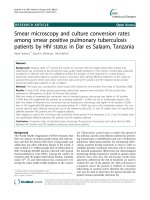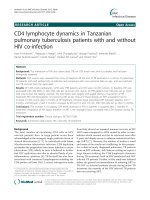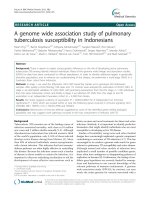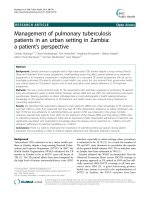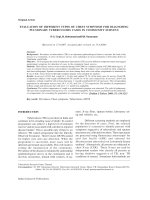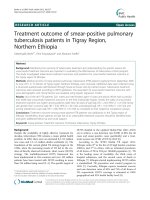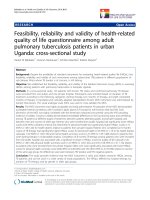Treatment outcome of smear-positive pulmonary tuberculosis patients in Tigray Region, Northern Ethiopia pptx
Bạn đang xem bản rút gọn của tài liệu. Xem và tải ngay bản đầy đủ của tài liệu tại đây (441.52 KB, 9 trang )
RES E AR C H A R T I C L E Open Access
Treatment outcome of smear-positive pulmonary
tuberculosis patients in Tigray Region,
Northern Ethiopia
Gebretsadik Berhe
1*
, Fikre Enquselassie
2
and Abraham Aseffa
3
Abstract
Background: Monitoring the outcome of tuberculosis treatment and understanding the specific reasons for
unsuccessful treatment outcome are important in evaluating the effectiveness of tuberculosis control program.
This study investigated tuberculosis treatment outcomes and predictors for unsuccessful treatment outcome in
the Tigray region of Ethiopia.
Methods: Medical records of smear-positive pulmonary tuberculosis (PTB) patients registered from September 2009
to June 2011 in 15 districts of Tigray region, Northern Ethiopia, were reviewed. Additional data were collected using
a structured questionnaire administered through house-to-house visits by trained nurses. Tuberculosis treatment
outcomes were assessed according to WHO guidelines. The association of unsuccessful treatment outcome with
socio-demographic and clinical factors was analyzed using logistic regression model.
Results: Out of the 407 PTB patients (221 males and 186 females) aged 15 years and above, 89.2% had successful
and 10.8% had unsuccessful treatment outcome. In the final multivariate logistic model, the odds of unsuccessful
treatment outcome was higher among patients older than 40 years of age (adj. OR = 2.50, 95% CI: 1.12-5.59), family
size greater than 5 persons (adj. OR = 3.26, 95% CI: 1.43-7.44), unemployed (adj. OR = 3.10, 95% CI: 1.33-7.24) and
among retreatment cases (adj. OR = 2.00, 95% CI: 1.37-2.92) as compared to their respective comparison groups.
Conclusions: Treatment outcome among smear-positive PTB patients was satisfactory in the Tigray region of
Ethiopia. Nonetheless, those patients at high risk of an unfavorable treatment outcome should be identified early
and given additional follow-up and social support.
Keywords: Smear-positive, Treatment outcome, Pulmonary tuberculosis, Tigray, Ethiopia
Background
Despite the availability of highly effective treatment for
decades, tuberculosis (TB) remains a major global health
problem. In 2010, there were an estimated 8.5–9.2 million
new cases and 1.2–1.5 million deaths worldwide [1]. The
foundation of the current global TB strategy began in the
1990s, when the increasing trends of TB led to the cre-
ation of directly observed treatment- short course (DOTS)
strategy. The multidimensional DOTS framework has
been implemented in 184 countries and over 132 million
patients have been treated with DOTS resulting in more
than 125 million being cured [2–5]. The specific targets of
DOTS detailed in the updated Global Plan (2011–2015)
are to achieve a case detection rate (CDR) of 84% (for all
cases and smear-positive cases specifically) and a treat-
ment success rate (TSR) of 87% by 2015 [6].
According to the WHO Global TB report 2011,
Ethiopia ranks 8
th
in the list of 22 high burden countries
(HBCs), and 3
rd
in Africa, with an estimated prevalence
of all forms of TB in 394 per 100,000 population [1]. TB
is the leading cause of morbidity, the third cause of
hospital admission, and the second cause of death in
Ethiopia [7]. Ethiopia started implementing DOTS within
a standardized TB prevention and control program in
1992 [7]. Currently, Ethiopia reports treatment success
and case detection rates of 83% and 72% of all forms of
TB, respectively. DOTS coverage is estimated at 100%
geographical and 95% health facility level [8].
* Correspondence:
1
College of Veterinary Medicine, Mekelle University, Mekelle, Ethiopia
Full list of author information is available at the end of the article
© 2012 Berhe et al.; licensee BioMed Central Ltd. This is an Open Access article distributed under the terms of the Creative
Commons Attribution License ( which permits unrestricted use, distribution, and
reproduction in any medium, provided the original work is properly cited.
Berhe et al. BMC Public Health 2012, 12:537
/>The Tigray region in Northern Ethiopia initiated
DOTS program in 1995 [9]. The Region has an esti-
mated population of 4.8 million, with a TB case notifica-
tion rate of 240 cases/100,000 population and a DOTS
geographical coverage rate of 100%. There were 168
functional TB diagnostic facilities in the region in 2010
[10]. The DOTS program has been introduced in all
hospitals, health centers and in most health posts in the
Region. The direct observation of TB treatment has been
decentralized from hospit als and health centers to health
posts [9,11]. According to the Region al Health Bureau
report, among smear-positive pulmonary tuberculosis
(PTB) cases evaluated in 2009, 4.6% died, 1.5% defaulted
and 0.8% failed contributing to a total of 2.7% unfavor-
able outcome [10].
Monitoring the outcome of treatment is essential in
order to evaluate the effectiveness of the DOTS progra m
[12]. Furthermore, understanding the specific reasons
for unsuccessful outcomes is important in order to
improve treatment systems [13]. In this regard, studies
in some parts of Ethiopia- Southern region [14] and
Gondar area [15] reported 74.8% and 29.5% treatment
success rates in TB patients, respectively. These and
various other studies in Southern region [14,16], Arsi
zone [17], Gondar area [15], as well as Addis Ababa area
of Ethiopia [18] have documented independent risk
factors for poor treatment outcome. These factors
include attending the regional capital health centre,
being on retreatment, having a positive smear at the sec-
ond month follow-up, age being more than 55 years,
being male, medication side effects, low body weight at
initiation of anti-TB treatment (<35 kg), year of enroll-
ment, distance from home to treatment centre and the
added burden of using public transport to get to a treat-
ment centre.
Despite the high DOTS region-wide coverage and the
progress made in TB control in the Tigray region of
Ethiopia, the treatment outcome of TB patients has not
been assessed so far. There is little information on what
factors are responsible for unsuccessful treatment out-
come in the Region. In this study, we assessed the treat-
ment outcomes of smear-positive PTB patients on DOTS
and identified factors associated with un-successful out-
come in the Tigray region of Ethiopia.
Methods
Study area
The study was carried out in Tigray region, Northern
Ethiopia. Ten rural and five urban districts in the five
zones (Southern, Eastern, Central, North Western and
Western zones) of the Region were included in the
study. Data were collected from all health centers
located in Atsbi-Wenberta, Saesie-Tsaedaemba, Enderta,
Tahtay-Koraro, Laelay-Maichew, Raya-Azebo, Adwa,
Offla, Asgede-Tsimbla, Setit-Humera , Kafta-Humera,
Korem, Adigrat, Ahferom, and Axum districts (Figure 1).
Study design and data collection
The determinants of treatment outcome were a ssessed
through retrospective and cross-sectional study designs.
A retrospective analysis was conducted on the profile
and treatment outcome of all smear-positive P TB
patients registered from September 2009 to June 2011 at
all DOTS facilities in the 15 selected districts. The
reviewed documents contained basic information such
as patient's age, sex, address, TB type, treatment cat-
egory, HIV status and treatment outcome. Additional
information was collected using a structured question-
naire through house-to-house visit of PTB patients
who were identified in a review of medical records. In
addition to the information in the TB Registry, we col-
lected data on income, educational status, family size,
religion, ethnicity, and distance from treatment centre
from all enrolled PTB patient.
Data were collected by trained nurses. The study
focused on smear-positive PTB patients because smear-
positivity results from harboring a highly contagious
form of M. tuberculosis and can be monitored for speed
of bacteriologic conversion on chemotherapy [19,20].
Sample size and sampling
In this study, sample size was calculated considering
the “proportion of smear-positive PTB patients with
unfavorable treatment outcome” as a predictor variable.
Sample size was determined using single population pro-
portion formula. The following parameters were taken
into account during calculation of sample size: preva-
lence of unfavorable outcome of 2.7% [10], 95% confi-
dence interval and a maximum discrepancy of + 3%
between the sample and the underlying population; then
the result was multiplied by 3 to consider the cluster
effect and increase power. Thus, a minimum number of
336 study subjects were required.
Multistage cluster sampling technique was used to
randomly select the different districts. Hence, ten rural
and five urban districts were selected by simple random
sampling method and smear-positive PTB patients from
the selected districts were recruited consecutively during
the limits of study period at these sites.
Exposure assessment and outcome definition
Exposure assessment
For each identified patient who underwent TB therapy
under DOTS, the following information was collected
from the medical records and the administered add-
itional questionnaire: age, sex, family size, religion , ethni-
city, place of residence, educational status, occupation,
treatment category, HIV status, distance from treatment
Berhe et al. BMC Public Health 2012, 12:537 Page 2 of 9
/>center and treatment outcome. For defaulters, time and
reasons for defaulting were also recorded.
Outcome definition
TB treatment outcome categories were defined according
to WHO and the International Union Against Tubercu-
losis and Lung Disease guideline [21]. WHO defines treat-
ment success as the sum of patients who are cured and
those who have completed treatment. In line with WHO
criteria, treatment outcomes were categorized into:
a. Successful outcome- if PTB patients were cured (i.e.,
negative smear microscopy at the end of treatment
and on at least one previous follow-up test) or
completed treatment with resolution of symptoms.
b. Unsuccessful outcome – if treatment of PTB
patients resulted in treatment failure (i.e., remaining
smear-positive after 5 months of treatment), default
(i.e., patients who interrupted their treatment for
two consecutive months or more after registration),
or death.
However, patients who transferred out to other districts
were excluded from the treatment outcome evaluation as
information on their treatment outcome was unavailable.
Statistical analysis
We used STATA Version 10.0 for windo ws program
(STATA Corp, College Station, Texas, USA) for data
analysis. Relationships between treatment outcomes and
potential predictor variables were assessed using bivari-
ate and multivariate logistic regression model. The age,
sex, family size, place of residence, educational status,
employment status, treatment category, HIV status and
distance from treatment centers of PTB patients were
subjected to multiv ariate analysis and the final model
was determined with enter method.
Ethical consideration
This study was approved by the respective institutional
review boards at College of Health Science, AAU and the
Armauer Hansen Research Institute. Written informed
consent was obtained from all study participants.
Results
Socio-demographic and clinical factors
A r eview of the treatment records o f 407 smear -positive
PTB patients was retrieved from all health centers found in
the study districts. Atsbi-Wenberta district had the highest
number of participants (12.0%) while Axum and Enderta
districts had the lowest number (both 1.2%) (Table 1).
Among the 407 patients enrolled in the study, 221
(54.3%) were males and 186 (45.7%) females (Table 2).
The mean age and standard deviation (SD) of study sub-
jects was 36.9 ± 15.3 (range: 15–82) years. Family size
varied from 1–10 persons (mean ± SD = 4.25 ± 2.0).
Income distribution among the study population showed
that 62.4% of the enrolled participants had less than 300
Figure 1 Rural and urban study districts in Tigray region, Northern Ethiopia.
Berhe et al. BMC Public Health 2012, 12:537 Page 3 of 9
/>Birr month ly income while 28.8% had between 300–999
Birr inc ome per month. Concerning educational status,
55.0% of the study participants were illiterate, 25.6% had
completed primary education, and 19.4% had completed
high-school and above. Occupationally, the patients
comprised 127 (31.2%) unemployed, 242 (59.5%)
unskilled workers, and 38 (9.3%) skilled workers. With
regard to HIV status, 8.6% of the patients were sero-
positive (Table 3).
Treatment outcomes and factors affecting the outcomes
Among the PTB patients enrolled in this study, 343
(85.5%) were cured, 18 (4.4%) had completed their treat-
ment and 6 (1.47%) were transferred out. From the 401
patients evaluated for treatment outcome, 357 (89%) had
successful and 44 (10.8%) unsuccessful outcomes. Of the
patients with unsuccessful treatment outcome, 15 (3.7%)
had treatment failure, 13 (3.2%) had defaulted and 16
(3.9%) had died (Table 2).
Bivariate and multivariate logistic regression analysis
was carried out for selected socio-demographic and clin-
ical risk factors including age, sex, family size, place of
residence, educational status , employment status, treat-
ment category of patients, HIV status and distance from
treatment centers. In the final multivariate logistic
model, the proportion recorded as having an unsuccess-
ful treatment outcome varied by age group, family size,
employment status and treatment category (Table 4).
The risk of unsuccessful treatment outcome was 2.5
(95% CI: 1.12-5.59) times higher among PTB patients
older than 40 years of age compared to those aged 15–
40 years. Compared to PTB patients having 1–5 family
size, those PTB patients having family size greater than
5 persons had 3.3 (95% CI: 1.43-7.44) times greater risk
of unsuccessful treatment outcome. Unemployed PTB
patients were more likely to experience (adjusted OR =
3.10, 95% CI: 1.33-7.24) unsuccessful outcome when
compared to their counterparts. Unsuccessful treatment
outcome was more frequent (adjusted OR = 2.00, 95%
CI: 1.37-2.92) among retreatment cases than among
those newly treated. Sex, residence type, educational
status, HIV status and distance from treatment center
of PTB patients did not show any statistically significant
association with unsuccessful treatment outcome in the
multivariate analysis (Table 4).
Discussion
Assessment of treatment outcome and analysis of factors
responsible for unsuccessful treatment outcome in
DOTS programs is of paramount importance particu-
larly in smear-positive PTB patients as they harbor a
highly contagious form of M. tuberculosis that can be
Table 1 Distribution of study participants by districts in
Tigray region of Ethiopia
S. No. Districts Residence
type
No. of
observations
Percent
1 Adigrat town Urban 23 5.65
2 Adwa town Urban 25 6.14
3 Ahferom Rural 41 10.07
4 Asgede Tsimbla Rural 40 9.83
5 Astbi Wenberta Rural 49 12.04
6 Axum town Urban 5 1.23
7 Enderta Rural 5 1.23
8 Humera town Urban 40 9.83
9 Kafta Humera Rural 23 5.65
10 Korem town Urban 25 6.14
11 Laelay Maichew Rural 12 2.95
12 Offla Rural 40 9.83
13 Raya Azebo Rural 11 2.70
14 Saesie Tsaedaemba Rural 38 9.34
15 Tahtay Koraro Rural 30 7.37
Total 407 100.00
Table 2 Treatment outcomes of smear-positive PTB patients by age and sex in Tigray region, Ethiopia
Characteristics Total
(n = 407)
Cured Treatment
completed
Death Treatment
failure
Defaulted Transfer
out
Age (years)
15-24 99 84 4 4 4 2 1
25-34 99 86 2 2 3 3 3
35-44 88 74 4 3 3 4 0
45-54 53 41 6 2 2 2 0
55-65 39 30 1 3 3 1 1
65+ 29 24 1 2 0 1 1
Sex
Female 186 160 8 4 6 6 2
Male 221 179 10 12 9 7 4
Berhe et al. BMC Public Health 2012, 12:537 Page 4 of 9
/>monitored for speed of bacteriologic conversion on
chemotherapy [19,20].
In this study, treatment success in smear-positive PTB
patients was 89.0%, slightly higher than the WHO inter-
national target of 87% (updated target 2011–2015) but
remarkably higher than previous studies conducted
in some parts of Ethiopia including 74.8% in Southern
region [14] and 29.5% in Gondar area of Ethiopia [15].
A recent community-randomized trial intervention
in Southern Ethiopia has also reported a similarly high
proportion of successful outcome (89.3%) using health
extension workers (HEWs) to follow-u p the patients
[22]. Our finding of higher successful outcome in Tigray
region as compared to other areas in Ethiopia could be
the result of the decentralization of DOTS to health
posts in Tigray region that has substantially reduced
treatment default from 32% in 1996 to 15% in 2003 [9].
According to the report, this was attributed to two main
factors: health posts nearer to patients' residence and
the use of volunteer community health workers (CHWs)
in tracing patients who default from treatment [9]. This
is also consistent with a finding in Tanzania where com-
munity based DOTS had higher successful outcome rate
(81%) as compared to facility based DOTS (70%) [23].
Another likely reason for the higher successful outcome
could be the 100% physical access to a treatment centre
in the Region [10]. A study conducted in Addis Ababa
reported that patients’ attitude and behavior towards the
disease are major factors influencing treatment adher-
ence [24]. This higher successful treatment outcome rate
in Tigray region implies that DOTS performance is
encouraging and the region is on the right track in
achieving the WHO targets and the millennium develop-
ment goals (MDG) in TB control.
The 10.8% unsuccessful outcome found in this study is
comparatively lower than the 16.7% report from South-
ern Ethiopia [14] and the 11.3% default rate in Arsi Zone
of Oromia [17]. The 3.2% default and 3.9% death rate
recorded in this study is also lower when compared with
the corresponding outcomes from Gondar area, North-
west Ethiopia, where 18.3% patients had defaulted and
10.1% had died [15]. Studies conducted in other parts of
Ethiopia recorded higher proportion of poor outcome
[14,15,17] compared to our data. This difference could
be due to variation in DOTS performance in the various
study areas. This could be attributed to the use of com-
munity health workers in tracing and follow-up of TB
patients in Tigray region [9] and Southern Ethiopia [22]
that has resulted in an improved performance of DOTS
as compared to other areas that do not use this strategy.
Other reasons for this variation could be the difference
in duration of study period, sample size and study
setting. For example, the study in Southern Ethiopia
was conducted over a longer period (2002–2007) and
Table 3 Socio-demographic and clinical characteristics of
smear-positive PTB patients in Tigray region, Ethiopia
Characteristics Frequency Percent
Age (years)
15-40 253 62.2
>40 154 37.8
Sex
Female 186 45.7
Male 221 54.3
Family size
1-5 262 64.4
>5 145 35.6
Religion
Orthodox Christians 384 94.35
Others 23 5.65
Ethnic group
Tigrawai 386 94.9
Amhara 16 3.9
Afar 5 1.2
Residence
Urban 196 48.2
Rural 211 51.8
Educational status
Illiterate 224 55
Elementary 104 25.6
High school 62 15.2
College 17 4.2
Occupation
Unemployed 127 31.2
Unskilled worker 242 59.5
Skilled worker 38 9.3
Income (Birr)
< 300 254 62.4
300-999 117 28.8
> 1000 36 8.8
Treatment category+
New cases 379 94.5
Re-treatment cases 22 5.5
HIV status
Positive 35 8.6
Negative 271 66.6
Unknown 101 24.8
Distance to treatment center+
<= 10 km 219 54.6
> 10 km 182 45.4
+The totals add up to 401 (Transfer out cases were not included).
Berhe et al. BMC Public Health 2012, 12:537 Page 5 of 9
/>involved more than 6547 patients. Unlike our study, the
study in Gondar area, Northwest Ethiopia, was con-
ducted in a hospital setting.
Elsewhere in Africa, different outcomes had been
reported in different countries. A study conducted in
Nigeria recorded 76.6% cured, 8.1% failed, 6.6% defaulted,
2% treatment interruption, 4.8% transferred out, and 1.9%
died [25]. Another study in Tanzania reported treatment
success rates of 81% and 70% in patients under commu-
nity vs. facility-based DOTS, respectively [23]. Among
the 4003 smear-positive PTB patients evaluated on
DOTS in Malawi, 72% had completed treatment, 20%
had died, 4% defaulted, 2% were transferred out and 1%
had still positive smears at the end of treatment [26].
In a multivariate regression model, this study showed
that unsuccessful treatment outcome was significantly
higher among patients older than 40 years of age, family
size greater than 5 persons, among those unemployed
and amongst re-treatment patients, as compared to
their counterparts.
Our observation of poor outcome in patients older
than 40 years of age as compared to those aged 15–
40 years is in agreement with the findings of previous
studies in which older age increases the risk for unfavor-
able treatment outcome [13–15,27–30]. One study
stated that an age in excess of 46 years was found to
be a significant risk factor for non-successful treatment
outcome [27 ]. Another study in Thailand showed that
an age of above 60 years was significantly correlated
with treatment interruption and treatment failure [29].
Higher age has been previously reported to be a risk factor
for death [15,31]. It was documented that indiv iduals at
Table 4 Logistic regression analyses of factors associated with treatment outcome in smear-positive PTB patients in
Tigray region, Ethiopia
Characteristics Treatment outcome
N* Unsuccessful n (%) COR (95% CI) AOR (95% CI)
Age (years)
15-40 249 18 (7.2) 1.00 1.00
>40 152 26 (17.11) 1.25(1.39-5.02) 2.50 (1.12-5.59)
Sex
Female 184 18 (9.78) 1.00 1.00
Male 217 26 (11.98) 1.25 (0.66-2.37) 0.97 (0.44-2.15)
Family size
1-5 259 21 (8.11) 1.00 1.00
>5 142 23 (16.19) 2.19 (1.16-4.11) 3.26 (1.43-7.44)
Residence
Urban 193 20 (10.36) 1.00 1.00
Rural 208 24 (11.54) 1.13 (0.60-2.11) 0.70 (0.29-1.67)
Educational status
Formal education 170 12 (7.06) 1.00 1.00
Illiterate 231 32 (13.85) 2.12 (1.06-4.24) 2.36 (0.95-5.85)
Employment
Employed 276 26 (9.42) 1.00 1.00
Unemployed 125 18 (14.40) 1.62 (0.85-3.07) 3.10 (1.33-7.24)
Category of treatment
New smear positive 379 36 (9.62) 1.00 1.00
Re-treatment cases 22 8 (36.36) 1.75 (1.28-2.39) 2.00 (1.37-2.92)
HIV status
Negative 268 29 (10.82) 1.00 1.00
Positive 35 7 (20,00) 2.06 (0.83-5.14) 1.84 (0.63-5.39)
Distance to treatment center
<= 10 km 219 25 (11.41) 1.00 1.00
> 10 km 182 19 (10.44) 0.90 (0.48-1.70) 0.96 (0.40-2.28)
N = Number of observations; COR = Crude odds ratio; AOR = Adjusted odds ratio; CI = Confidence interval.
* The total number of patients evaluated across each subgroup adds up to 401 excluding the 6 patients who were transferred out to other districts.
Berhe et al. BMC Public Health 2012, 12:537 Page 6 of 9
/>the extremes of age had the poorest outcomes [14].
Older individuals often have concomitant diseases and
general physiological deterioration with age, less able to
reach health facilities and are also poorer than the
younger population [14,32-34].
Data from this study revealed that retreatment cases
have an increased risk of unsuccessful outcome com-
pared to new cases. This is consistent with other pub-
lished reports, in which history of prior TB treatment
was significantly associated with unsuccessful treatment
outcome [14 ,18,27,29,35,36]. It is also reported that prior
sub-optimal therapy is known to be a major contributor
to the development of multidrug resistance (MDR) TB
[37]. Thus, the high proportion of unsuccessful outcome
in retreatment cases in our study could be related to a
higher frequency of drug resistance. The prevalence of
MDR TB in Ethiopia is estimated to be 1.6% among new
cases and 12% among retreatment cases [5]. According
to a previous study, risk factors for unsuccessful out-
come were associated with patient behavior and atti-
tudes, as patients registered as defaulters tend to default
again [14]. Other risk factors include selection of drug-
resistant strains and the development of severe and
complicated forms of the disease, all of which contribute
to poor outcome among previously treated patients [14].
The higher proportion of unsuccessful treatment out-
come in patients with family size greater than 5 persons
or those unemployed could be due to the relation of un-
employment and larger family sizes to low income.
Patients with low income often suffer from malnutrition
which may result in more drug side effects and low
stamina among patients and may possibly lead to poor
adherence, death or discontinuation of anti-TB chemo-
therapy. A study in Estonia [38] and Brazil [39] sug-
gested that one of the main risk factors for TB was
poverty. In our study, the majority of the TB patients
(62.4%) had very low family income (<300 Birr per
month). In agreement with this study, another study
reported that unemployment was highly associated with
unfavorable treatm ent outcome [40].
Unlike the results of other studies, factors such as sex
of patients, educational status, HIV status, and distance
from treatment center did not show any statistically sig-
nificant association with unsuccessful treatment out-
come. According to man y reports, urban residents
[15,40] and women [13,15,41] had higher probabilities of
successful treatment outcome.
The lack of any appreciable link between HIV status of
patients and distance from treatment centre with TB
treatment outcome was somewhat unexpected. Other
studies had also indicated that most of the factors asso-
ciated with treatment non-completion, apart from the
patient’s age and level of education, are those related
to physical access to health-care ser vices [16]. These
differences between this study and other study results
could be explained by differences in sample size among
the studies, difference in disease burden, and socio-
demographic factors. Variations in environmental factors
or true biological effects, or even a combination of all
factors could also explain the differences in the study
results. In Tigray region, access to health care services
was facilitated by the community health workers and
this may have contributed to improved outcome, includ-
ing for the HIV co-infected patients.
Previous studies established that HIV is associated
with unsuccessful treatment outcomes which include
treatment interruption [29] and death [35]. As previously
reported, smear-negative PTB patients had the lowest
rate of successful treatment outcome [42,43]. These
patients have a higher frequency of HIV co-infection; in
addition, they may be less able to develop an adequate
immune response to control the infection; furthermore
their diagnosis is difficult, often resulting in treatment
delay and poor outcome [44]. Another study conducted
in Ethiopia has shown that HIV-positive patients are
more likely to default than HIV-negatives [45]. This
study also reported default rates of nearly 19% in extra-
pulmonary TB (EPTB) and approximately 28% in smear-
negative PTB (including EPTB). This and other related
studies have indicated a background of HIV infection in
these types of TB [45]. Thus, on the other hand, the lack
of association between HIV status and unsuccessful
treatment outcome observed in this study may be due
to the exclusion of these forms of TB associated with
HIV infection.
The strength of this study lies in its ability to collect
verified data from TB patients to determine treatment
outcomes. Studying 15 randomly selected districts has
enabled us to generalize our findings to the Region.
Otherwise, the study was partly based on retrospective
design; therefore, selection bias could occur as we
were unable to trace the whereabouts of some patients.
Other important variables including patient-health
worker communication, delay in health care seeking
and provider and health system related factors were
not assessed. Furthermore, treatment outcome and asso-
ciated risk factors for patients with extra-pulmonary TB,
those with smear-negative PTB and patients younger
than 15 years of age were also not evaluated in this
study.
Conclusions
This study has demonstrated the success of DOTS pro-
gram in smear-positive PTB patients in the Tigray re-
gion, Northern Ethiopia. Moreover, the following risk
factors were identified as predictors of unsuccessful
treatment outcome: older age, family sizes greater than
5 persons, unemployed and retreatment cases. Following
Berhe et al. BMC Public Health 2012, 12:537 Page 7 of 9
/>this observation, we recommend that patients at high
risk of unsuccessful treatment outcome should be identi-
fied early and given additional follow-up and a combin-
ation of additiona l medical intervention and social
support.
Competing interest
The authors declare that there is no competing interest among authors.
Acknowledgements
The authors would like to thank study participants and the staffs of the
Tigray Health Bureau who were involved in the data collection process. We
also thank Mr Atkilt Girma for preparing the map of the study area. This work
was funded by the Armauer Hansen Resear ch Institute, Addis Ababa
University and Mekelle University.
Author details
1
College of Veterinary Medicine, Mekelle University, Mekelle, Ethiopia.
2
School
of Public Health, Addis Ababa University, Addis Ababa, Ethiopia.
3
Armauer
Hansen Research Institute, Addis Ababa, Ethiopia.
Authors’ contribution
GB participated in all phases of preparation of the manuscript starting from
inception of the project, collection of data, analysis and interpretation of
results and writing of the manuscript and as corresponding author. FE
contributed to interpretation of the data and writing of the manuscript. AA
has participated in the design of the study, the interpretation of results and
writing of the manuscript. All authors read and approved the final
manuscript.
Received: 20 December 2011 Accepted: 10 July 2012
Published: 23 July 2012
References
1. World Health Organization: Global Tuberculosis Control. Geneva: World
Health Organization; 2011.
2. World Health Organization: Forty-fourth World Health Assembly. Geneva:
World Health Organization; 1991. />2DDF1ABF-8ACC-496F-B936-ED01F81ACC0C/0/WHA445.pdf.
3. Raviglione MC, Pio A: Evolution of WHO policies for tuberculosis control,
1948–2001.Lancet 2002, 359:775–780. />Raviglione%20-%20WHO%20Policies%20for%20TB%20Control.pdf.
4. Lönroth K, Raviglione M: Global epidemiology of tuberculosis: Prospects
for control. Semin Respir Crit Care Med 2008, 29:481–491. http://www.
uptodate.com/contents/epidemiology-of-tuberculosis/abstract/2?
utdPopup=true.
5. World Health Organization: Global Tuberculosis Control. Geneva: World
Health Organization; 2009. />9789241563802_eng.pdf.
6. The global plan to stop TB, 2011–2015/Stop TB Partnership: Transforming
the fight towards elimination of tuberculosis. Geneva: World Health
Organization; 2010. />TB_GlobalPlanToStopTB2011-2015.pdf.
7. Ministry of Health of Ethiopia: Tuberculosis, Leprosy and TB/HIV Prevention
and Control Programme Manual. Addis Ababa: MOH. 4th edition. 2008.
8. Federal Ministry of Health: Overview of National TB Control Implementation
status. Gondar, Ethiopia: Sixth National TB Research Workshop, Gondar
University, 6–8 June 2011; 2011.
9. Mengiste MM: Community-Based Directly Observed Treatment Short
course strategy in pilot districts of Tigray: Overview of baseline studies.
Ethiop J Health Dev 2005, 19(Special Issue):3–6.
10. Tigray Health Bureau: nnual TB performance report in Tigray region. Gondar,
Ethiopia: Sixth National TB Research Workshop, Gondar University, 6–8
June 2011; 2011.
11. Mengiste MM, Tesfay WT, Madeley JR: The quality of tuberculosis diagnosis in
districts of Tigray region of northern Ethiopia. Ethiop J Health Dev 200 5, 19
(Special Issue):13–20. http:// ejhd.uib.no/ejhd19-sp ecial%2 0issue%20tuberculosis/
13.%20The%20quality%20of%20tu berculosis%20diagnosis.pdf.
12. Veen J, Raviglione M, Rieder HL, Migliori GB, Graf P, Grzemska M, Zalesky R:
Standardized tuberculosis treatment outcome monitoring in Europe.
Working Group Recommendations. Eur Respir J 1998, 12:505 – 510. http://
erj.ersjournals.com/content/12/2/505.long.
13. Tuula V, Pekka H, Jukka O, Kari L, Maarit K, Petri R: Risk factors for poor
tuberculosis treatment outcome in Finland: a cohort study. BMC Public
Health 2007, 7:291
–299. />PMC2099439/].
14. Muñoz-Sellart M, Cuevas LE, Tumato M, Merid Y, Yassin MA: Factors
associated with poor tuberculosis treatment outcome in the Southern
Region of Ethiopia. INT J TUBERC LUNG DIS 2010, 14(8):973–979.
/>68394092.1/iuatld/ijtld/2010/00000014/00000008/art00010/
0A6CFC6683126EB713349018795BE67560E71A5D76.pdf?link=http://www.
ingentaconnect.com/error/delivery&format=pdf.
15. Tessema B, Muche A, Bekele A, Reissig D, Emmrich F, Sack U: Treatment
outcome of tuberculosis patients at Gondar University Teaching
Hospital, Northwest Ethiopia. A five - year retrospective study. BMC Public
Health 2009, 9:371–378. />16. Shargie EB, Lindtjørn B: Determinants of treatment adherence among
smear-positive pulmonary tuberculosis patients in southern Ethiopia.
PLoS Med 2007, 4(2):e37. />17. Tekle B, Mariam DH, Ali A: Defaulting from DOTS and its determinants in
three districts of Arsi Zone in Ethiopia. Int J Tuberc Lung Dis 2002,
6(7):573–579. />68394173.1/iuatld/ijtld/2002/00000006/00000007/art00005/
A4F5F407D1E7E4671334902433145D52BA268CA00A.pdf?link=http://www.
ingentaconnect.com/error/delivery&format=pdf.
18. Getahun B, Ameni G, Biadgilign S, Medhin G: Mortality and associated risk
factors in a cohort of tuberculosis patients treated under DOTS
programme in Addis Ababa, Ethiopia. BMC Infectious Diseases 2011,
11:127–134. />19. Rieder HL: Sputum smear-conversion during directly observed treatment
for tuberculosis. Tubercle Lung Dis 1996, 77:124–129.
20. Liippo KK, Kulmala K, Tala EOJ: Focusing tuberculosis contact tracing by
smear grading of index cases. Am Rev Respir Dis 1993, 148 :235–236.
21. Veen J, Raviglione M, Rieder HL, Migliori GB, Graf P, Grzemska M, Zalesky R:
Standardized tuberculosis treatment outcome monitoring in Europe.
Recommendations of a Working Group of the World Health
Organization (WHO) and the European Region of the International Union
Against Tuberculosis and Lung Disease (IUATLD) for uniform reporting
by cohort analysis of treatment outcome in tuberculosis patients. Eur
Respir J 1998, 12:505–510. />22. Datiko DG, Lindtjørn B: Health Extension Workers Improve Tuberculosis
Case Detection and Treatment Success in Southern Ethiopia: A
Community Randomized Trial. PLoS ONE 2009, 4(5):e5443. http://www.
plosone.org/article/info%3Adoi%2F10.1371%2Fjournal.pone.0005443.
23. van den Boogaard J, Lyimo R, Irongo CF, Boeree MJ, Schaalma H, Aarnoutse
RE, Kibiki GS: Community vs. facility-based directly observed treatment
for tuberculosis in Tanzania's Kilimanjaro Region. Int J Tuberc Lung Dis
2009, 13(12)):1524–1529. />u/d/ISIS/68394300.1/iuatld/ijtld/2009/00000013/00000012/art00014/
941DFC571995AB8A1334903092386248F6C455AA29.pdf?link=http://www.
ingentaconnect.com/error/delivery&format=pdf.
24. xGelaw M, Genebo T, Dejene A, Lemma E, Eyob G:
Attitude and social
consequences of tuberculosis in Addis Ababa, Ethiopia. East Afr Med J
2001, 78:382–388.
25. Fatiregun AA, Ojo AS, Bamgboye AE: Treatment outcomes among
pulmonary tuberculosis patients at treatment centers in Ibadan, Nigeria.
Ann Afr Med 2009, 8:100–104. />2/100/56237.
26. Harries AD, Nyirenda TE, Banerjee A, Boeree MJ, Salaniponi FM: Treatment
outcome of patients with smear-negative and smear-positive pulmonary
tuberculosis in the National Tuberculosis Control Programme, Malawi.
Trans R Soc Trop Med Hyg. 1999, 93(4):443–446.
27. Talay F, Kumbetli S, Altin S: Factors associated with treatment success for
tuberculosis patients: a single center's experience in Turkey. Jpn J Infect
Dis 2008, 61(1):25–30. />28. Nik Nor Ronaidi NM, Mohd NS, Wan Mohammad Z, Sharina D,
Nik Rosmawati NH: Factors associated with unsuccessful treatment
outcome of Pulmonary tuberculosis in kota Bharu, kelantan. Malaysian
Journal of Public Health Medicine 2011, 11(1):6–15. .
my/mjphm/journals/Volume%2011:1/174-11-TO%20PUBLISH.pdf.
Berhe et al. BMC Public Health 2012, 12:537 Page 8 of 9
/>29. Anunnatsiri S, Chetchotisakd P, Wanke C: Factors associated with
treatment outcomes in pulmonary tuberculosis in northeastern Thailand.
Southeast Asian J Trop Med Public Health 2005, 36(2):324–30.
30. Farah MG, Tverdal A, Steen TW, Heldal E, Brantsaeter AB, Bjune G:
Treatment outcome of new culture positive pulmonary tuberculosis in
Norway. BMC Public Health 2005, 5:14–20. />content/pdf/1471-2458-5-14.pdf.
31. Jyh Lee JJ, Wu RL, Lee YS, Wu YC, Chiang CY: Treatment Outcome of
Pulmonary Tuberculosis in Eastern Taiwan—Experience at a Medical
Center. J Formos Med Assoc 2007, 106:25–30. encedirect.
com/science/article/pii/S0929664609602126.
32. Zellweger JP, Coulon P: Outcome of patients treated for tuberculosis in
Vaud County, Switzerland. Int J Tuberc Lung Dis 1998, 2:372–377. http://
docstore.ingenta.com/cgi-bin/ds_deliver/1/u/d/ISIS/68394386.1/iuatld/ijtld/
1998/00000002/00000005/art00004/
55ADBEF68F7355251334903523B36D2439624C3C51.pdf?link=http://www.
ingentaconnect.com/error/delivery&format=pdf.
33. Cayla JA, Caminero JA, Rey R, Lara N, Valles X, Galdos-Tanguis H: Working
Group on Completion of Tuberculosis Treatment in Spain: Current status
of treatment completion and fatality among tuberculosis patients in
Spain. Int J Tuberc Lung Dis 2004, 8:458–464. />cgi-bin/ds_deliver/1/u/d/ISIS/68394416.1/iuatld/ijtld/2004/00000008/
00000004/art00012/4EA0C3B19C2462CF1334903659B3A7F76CC8977DB6.
pdf?link= />34. Falzon D, Le Strat Y, Belghiti F, Infuso A: Euro TB Correspondents:
Exploring the determinants of treatment success for tuberculosis cases
in Europe. Int J Tuberc Lung Dis 2005, 9:1224–1229. enta.
com/cgi-bin/ds_deliver/1/u/d/ISIS/68394431.1/iuatld/ijtld/2005/00000009/
00000011/art00009/78F487B6410B228C1334903769A2AE38319821DDF4.pdf?
link= />35. de Albuquerque MF, Ximenes RA, Lucena- Silva N, et al: Factors associated
with treatment failure, dropout, and death in a cohort of tuberculosis
patients in Recife, Pernambuco State, Brazil. Cad Saude Publica 2007,
23(7):1573–82. />36. Vijay S, Kumar P, Chauhan LS, Narayan Rao SV, Vaidyanathan P: Treatment
Outcome and Mortality at One and Half Year Follow-Up of HIV Infected
TB Patients Under TB Control Programme in a District of South India.
PLoS ONE 2011, 6(7):e21008. />2F10.1371%2Fjournal.pone.0021008.
37. Alpert PL, Munsiff SS, Gourevitch MN, Greenberg B, Klein RS: A prospective
study of tuberculosis and HIV, clinical manifestations and factors
associated with survival. Clin Infect dis 1997, 24:661–668. http://cid.
oxfordjournals.org/content/24/4/661.long.
38. Tekkel M, Rahu M, Loit HM, Baburin A: Risk factors for pulmonary
tuberculosis in Estonia. Int J Tuberc Lung Dis 2002, 6(10):887
–94. http://
docstore.ingenta.com/cgi-bin/ds_deliver/1/u/d/ISIS/68394532.1/iuatld/ijtld/
2002/00000006/00000010/art00007/
588C29D9FCB56FC91334904286B5B5ADD934AFFAED.pdf?link=http://www.
ingentaconnect.com/error/delivery&format=pdf.
39. Belo MTC, Luiz RR, Teixeira EG, Hanson C, Trajman A: Tuberculosis
treatment outcomes and socio-economic status: a prospective
study in Duque de Caxias, Brazil. INT J TUBERC LUNG DIS 2011,
15(7):978–981. />d/ISIS/68394580.1/iuatld/ijtld/2011/00000015/00000007/art00021/
CBCE66536D4801B1133490450503561A51CE0C6DE1.pdf?link=http://www.
ingentaconnect.com/error/delivery&format=pdf.
40. Ekaterina B, Ajeilat S, Dadu A, Aitmagambetova I, Ershova J, Fagan R,
Favorov MO: Progress Toward Tuberculosis Control and Determinants
of Treatment Outcomes Kazakhstan, 2000—2002. MMWR 2006,
55(SUP01):11–15. />su5501a4.htm.
41. Szczuka I: Cohort analysis for treatment outcomes TB pulmonary cases
bacteriologically confirmed in Poland. Pneumonol Alergol Pol 2005,
73(3):245–53. />42. World Health Organization: Global tuberculosis control 2008. Surveillance,
planning, fi nancing. WHO report 2008. WHO/HTM/TB/2008.393. Geneva,
Switzerland: WHO; 2008.
43. Parry E, Godfrey R, Mabey S, Gill G: Principles of medicine in Africa. 3rd
edition. Cambridge, UK: Cambridge University Press; 2004.
44. Yassin MA, Takele L, Gebresenbet S, et al: HIV and tuberculosis coinfection
in the southern region of Ethiopia: a prospective epidemiological study.
Scand J Infect Dis 2004, 36:670–673. />10.1080/00365540410020848.
45. Mitike G, Kebede D, Yeneneh H: HIV infection and anti tuberculosis drug
resistance among pulmonary TB patients in Harar Tuberculosis Center,
Ethiopia. East Afr Med J 1997, 74:154–157. />pubmed/9185411.
doi:10.1186/1471-2458-12-537
Cite this article as: Berhe et al.: Treatment outcome of smear-positive
pulmonary tuberculosis patients in Tigray Region, Northern Ethiopia.
BMC Public Health 2012 12:537.
Submit your next manuscript to BioMed Central
and take full advantage of:
• Convenient online submission
• Thorough peer review
• No space constraints or color figure charges
• Immediate publication on acceptance
• Inclusion in PubMed, CAS, Scopus and Google Scholar
• Research which is freely available for redistribution
Submit your manuscript at
www.biomedcentral.com/submit
Berhe et al. BMC Public Health 2012, 12:537 Page 9 of 9
/>
